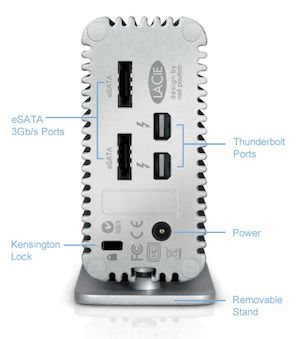GRAPH LEGEND
Internal 6G SSD = 6Gb/s SSD inside the late 2011 MacBook Pro
Echo SPro6 miniS_r0 = Echo Pro + Tempo SATA Pro 6Gb/s ExpressCard/34 (model TSATA6-PRO2-E34) to the FirmTek miniSwap/ES dual bay enclosure with dual OWC Mercury Extreme Pro 6Gb/s SSDs
Echo Edge Promini = Echo Pro + Tempo edge SATA Pro 6Gb/s ExpressCard/34 (model TSATA6-PRO1-E34) to OWC Mercury Elite Pro mini enclosure with single OWC Mercury Extreme Pro 6Gb/s SSD
Echo Edge Gmini_r1 = Echo Pro + Tempo edge SATA Pro 6Gb/s ExpressCard/34 (model TSATA6-PRO1-E34) to NewerTech Guardian MAXimus mini with dual OWC Mercury Extreme Pro 6Gb/s SSDs in hardware RAID 1 mode.
LaHub miniS_r0 = LaCie eSATA Hub to the FirmTek miniSwap/ES dual bay enclosure with dual OWC Mercury Extreme Pro 6Gb/s SSDs
LaHub Promini = LaCie eSATA Hub to OWC Mercury Elite Pro mini enclosure with single OWC Mercury Extreme Pro 6Gb/s SSD
LaHub Gmini_r1 = LaCie eSATA Hub to NewerTech Guardian MAXimus mini with dual OWC Mercury Extreme Pro 6Gb/s SSDs in hardware RAID 1 mode
Internal 3G SSD = Apple (Samsung) factory 3G SSD inside the late 2011 MacBook Pro
Test "mule" was the 'late 2011' MacBook Pro 2.5GHz Quad-Core i7 running OS X Lion 10.7.4.
INSIGHTS and ANALYSIS
The LaCie eSATA Hub is a simple and efficient means for connecting eSATA enclosures to your 2011 Mac's Thunderbolt port. No driver is required. It's plug and play. It includes a second Thunderbolt port in case you want to daisy chain another Thunderbolt device. There are a few caveats, though.
- It is limited to devices with eSATA interface. If you want a Thunderbolt hub to access other types of interfaces (FireWire, USB, HDMI, etc.), you must look elsewhere.
- It does require an AC adapter. But then, so does your eSATA device. If you need everything bus powered for convenient on-the-road setups, then you'll need to use either USB or FIreWire, or bus-powered Thunderbolt devices.
- It's relatively heavy at 23 oz (including AC adapter). Compare that to the Sonnet Echo Pro "hub" that weights 7 oz including ExpressCard.
In the graphs above, we pit the LaCie eSATA Hub against a competing product, the Sonnet Technologies Echo ExpressCard Pro Thunderbolt Adapter with their newest 6Gb/s single and dual port eSATA ExpressCards. By using 6Gb/s rated enclosures with 6Gb/s SSDs, we were able to measure the maximum possible large sequential transfer speeds with single drives and with striped (RAID 0) drives.
When running a single 6Gb/s SSD, the Echo Pro produced faster read/write speeds. However, when running dual 6Gb/s SSDs in a striped array (RAID 0), the LaCie Hub was faster on both read and write. (NOTE Red bars in graphs.) Those results may look like a contradiction but keep in mind that the LaCie eSATA Hub is rated at 3Gb/s per port while the Echo Pro is only restricted by the ExpressCard in use.
A third scenario shown in the graphs was the use of an enclosure with dual 6Gb/s SSDs that shared a single eSATA port and which were configured in the box as a mirrored array (RAID 1). The nature of shared ports is that your transfer speeds are much lower. The lower transfer speeds are not the fault of RAID 1. When we configured the Guardian MAXimus mini as a RAID 0 device, the speeds were essentially the same. As you can see, the transfer speeds of the mini are about the same for both the LaCie eSATA Hub and the Echo Pro.
Fourthly, we included the transfer speeds of a 3GB/s SSD and 6Gb/s SSD mounted internally to the MacBook Pro used as the test mule. (NOTE Orange bars in graphs) That gives you a perspective on speeds attainable with SSDs when using the internal built-in 6Gb/s SATA interface. Compare those results to the single drive examples in the graphs labeled "Promini." The point is that the LaCie Hub and Echo Pro with a single 6Gb/s SSD will "beat" an internal Apple factory 3Gb/s SSD but run slower than an internal 6Gb/s SSD.
How does the LaCie eSATA Hub compare in single and dual drive speeds to the fastest pure Thunderbolt enclosure? The Promise Pegasus R4 tops out at 500MB/s with a single 6Gb/s SSD and 750MB/s with two 6Gb/s SSDs. Keep in mind that the R4 is a relatively large, bulky RAID enclosure with four drive bays. Even with four 6Gb/s SSDs, it maxes out at 864MB/s.
Caveats and bandwidth restrictions aside, the LaCie eSATA Hub remains a simple, efficient, and affordable means for connecting eSATA enclosures and devices to your Mac's Thunderbolt port.
ESATA ENCLOSURES THAT WORK WITH THE LACIE eSAT A HUB
A HUB
We have confirmed these to work:
FirmTek miniSwap/ES
FirmTek SeriTek/2EN2
TransIntl ProStor725
TransIntl ProStor735
NewerTech Guardian MAXimus
NewerTech Guardian MAXimus mini
OWC Mercury Elite Pro mini
CRU-DataPort RTX100-3SJ
CRU-DataPort RTX220-QR
Sonnet Fusion F2
LaCie d2
Some Oxford Semiconductor based quad interface enclosures do not work. Port-multiplier enclosures do not work.